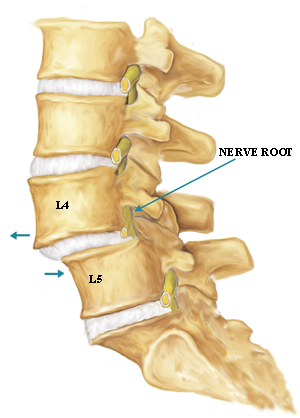The body weight is supported and the spinal cord is protected by the spine which is present from the bottom of the skull to the pelvis region. The spine has a characteristic "s" shape which gives the ability to tolerate immense amount of stress and allows it to distribute the body weight evenly. A case of spondylolisthesis or anterolisthesis such as grade 1 anterolisthesis can lead to pain in your spine.
What Is Anterolisthesis?
Vertebrae are the bones which construct the spine and allow an opening for the spinal cord by forming a passageway. The spine is comprised of 24 bones with the coccyx consisting of four bones and the sacrum consisting of 5 bones. The flat intervertebral discs which separate the stacked bones act as an absorber of shock for the vertebra and the spinal cord.
Anterolisthesis can lead to pain in the vertebrae of the spine. It is a condition where the vertebra in the upper body slips forwards on the vertebra in the lower body. As this displacement of the vertebra progresses, it can possibly pinch the nerves of spine which can lead to damage of the spinal cord. Anterolisthesis is usually detected in the 4th and 5th lumbar vertebrae and is one of the types of spondylolisthesis, describing the manner in which the vertebra has slipped.
Grade 1 Anterolisthesis
The degree of the slippage of the vertebrae determines the grade of anterolisthesis. The identification of the grade of anterolisthesis can be done with the help of lateral radiograph using the plain x-ray. Anterolisthesis can be divided into 5 grades and the first grade is least severe. This stage only has a slippage of about 25%.
Other Grades of Anterolisthesis
- Grade II: Here the slippage is about 26% to 50%.
- Grade III: This represents a forward slippage of 51% to 75%.
- Grade IV: It is a severe condition and has a forward slippage of about 76% to 100%.
- Grade V: In this condition the vertebra is completely detached from the adjacent vertebra.
Symptoms of Anterolisthesis
Anterolisthesis has several symptoms which are dependent on the severity of nerve damage or pinch due to slippage and also the region affected by forward slippage. Hence, grade 1 anterolisthesis has mild symptoms.
1. Pain
This symptom is the most easily noticeable and common type of symptom detected by people suffering from anterolisthesis.
Anterolisthesis may result in pain from muscle spasm due to aggravated tissue near the spine, disc and nerve roots. The pain can be either localized or diffused from the area of slippage. This pain may be reflected in the legs which can be perceived as weakness of one or both legs, which requires urgent medical attention.
2. Other Symptoms
- It is the failure of control of bladder or bowel due to severe compression of nerves.
- Severe compression of nerves leads to tingling and numbness in the legs.
- The pain due to the irritation of nerve roots and disc may also result in declined mobility in the lower back.
How to Treat Anterolisthesis
Several factors such as age, severity of slippage, general health and extent of symptoms influence the treatment for anterolisthesis. For example, grade 1 anterolisthesis would require less treatment. Treatment is usually conservative which involves rest, exercise and medication. Only in severe cases surgery is required.
1. Moderate Treatment
- X-rays must be done regularly to determine the state of slippage.
- Activities such as sports should be suspended until the trauma reduces.
- A back support or brace can be utilised to reduce the pain and stabilize the back.
- A non-steroidal anti-inflammatory drug (NSAID) such as naproxen or ibuprofen is suggested to reduce inflammation and pain. If this does not provide relief, then steroid shots for epidural area can be taken.
2. Physical Therapy
An exercise program of 2 to 3 months is required to achieve strengthening of back and abdominal muscles. This helps in minimizing the slippage of the spine and increasing muscle strength and flexibility. Below are some sample exercises:
3. Surgery
For grade 1 anterolisthesis, the above initial treatment can be of great help. But if they fail to relieve pain due to slippage of vertebrae which interferes the day-to-day activities, then surgery shall become necessary.
Surgery is mainly performed to reduce pain caused by the inflamed nerve, increase the functional ability of a person and balance the spine where slippage has occurred. Generally there are 2 procedures to treat anterolisthesis. They are:
- Decompressive laminectomy: In this procedure, the part of the bone that is pinching the nerves is removed. Even though it may reduce pain, it can lead to instability of the spine as a part of the bone is removed.
- Spinal fusion: In this procedure, a part of bone is fused to the spine. The fused piece of bone heals and creates a stable block of bone which keeps spine from moving and stabilizes it. In certain cases, implements such as screws and rods are utilized in order to hold the vertebra in place as it heals.